
Now, you might be asking yourself, “How do I even start?” Don’t worry; I’ve got you covered. Setting up an earthworm habitat is easier than you might think. It’s like creating a cozy little apartment for them. With a few simple steps and a little patience, you’ll have a thriving worm community in no time. Let’s dig into how to create that perfect space for your wriggly friends!
Why You Should Have an Earthworm Habitat
You might be wondering what the big deal is about earthworms. Why go through the trouble of creating a habitat? Well, let’s break it down. Earthworms are remarkable for their ability to aerate the soil. As they move through the earth, they create tiny tunnels that allow air, water, and nutrients to flow freely. This means healthier plants that can access all the good stuff they need to grow.
Moreover, earthworms help break down organic matter, turning kitchen scraps and yard waste into nutrient-rich compost. This process not only enriches the soil but also reduces the amount of waste we send to landfills. So, by creating an earthworm habitat, you’re doing your part for the planet while also enjoying the fruits of your labor—literally!
Plus, having a worm bin in your backyard is a great way for kids (and adults!) to learn about ecology and the importance of nature. It’s a mini-laboratory where you can watch the magic unfold right before your eyes. It’s educational, fun, and helps you connect with the earth.
Choosing the Right Location
When it comes to setting up your worm habitat, the **location** is key. Think about finding a spot that’s somewhat shady and protected from strong winds or heavy rain. Earthworms prefer moist environments, so a sheltered area will keep them happy.
Consider placing your habitat near your garden or vegetable patch. This way, you can easily access the compost they produce when it’s time to nourish your plants. Just make sure it’s not too close to any chemical treatments or pesticides, as these can harm your worms.
You might also want to avoid direct sunlight. Too much sun can dry out the habitat, making it uncomfortable for your worms. If the area you choose gets some sunlight, maybe think about building a simple shade structure. A tarp or even a few strategically placed plants can help keep your worm home cool and inviting.
Building a Worm Bin
Now that you’ve picked the perfect spot, it’s time to construct your worm habitat—or as it’s commonly called, a worm bin. You can buy a pre-made worm bin, but making one yourself is pretty easy and budget-friendly.
To get started, you’ll need:
- A sturdy bin (think plastic storage container or wooden crate).
- A drill (if you’re using a plastic bin, you’ll need it for air holes).
- Moist bedding material like shredded newspaper, cardboard, or coconut coir.
- Kitchen scraps (vegetable peels, coffee grounds, eggshells).
Once you have your materials, drill a few small holes in the bin lid and sides for airflow. Next, layer the bottom with damp bedding material. This provides a comfortable environment for your worms and helps retain moisture. Then, add your kitchen scraps on top. Finally, it’s time to introduce the stars of the show—your earthworms!
Choosing the Right Earthworms
Not all worms are created equal when it comes to composting. The most popular type for this purpose is the **Red Wiggler Worm**. These little guys thrive in compost bins and are excellent at breaking down organic matter. If you’re serious about your worm habitat, you can usually find them at garden centers or online.
When you first introduce your worms to their new home, give them a bit of time to acclimate. It’s best to start with a small number—around 100—if your bin is medium-sized. Over time, they’ll reproduce and create a bustling community all on their own.
Once you have your red wigglers settled in, be sure to keep their environment moist but not soggy. You can add a splash of water or more damp bedding if it seems too dry. Just like us, worms enjoy a comfy habitat!
Feeding Your Earthworms
Feeding your earthworms is pretty straightforward, but there are a few guidelines to keep in mind. Earthworms love organic matter, but not everything is suitable. Try to stick with:
- Vegetable scraps (like carrot peels, lettuce, and potato skins).
- Coffee grounds and filters.
- Crushed eggshells (great for calcium).
Avoid feeding them anything spicy or acidic, like citrus peels, as this can upset their delicate system. You might be thinking, “How do I know how much to feed them?” A good rule of thumb is to start with about half a pound of scraps for every pound of worms you have each week.
Make sure to spread the food evenly and cover it with some bedding. This helps keep odors down and prevents fruit flies from becoming an issue. Trust me; a little organization goes a long way in keeping your worm habitat pleasant!
Maintaining Your Worm Habitat
Maintaining your earthworm habitat is crucial for keeping your little ecosystem thriving. Regularly check on the moisture level; you want it to feel like a damp sponge—wet but not dripping. If it gets too dry, mist it lightly with water. On the flip side, if it feels too wet, you might need to add more bedding material to soak up excess moisture.
You should also monitor the food levels. If you notice that the scraps are disappearing quickly, that’s a good sign your worms are happy. If there are uneaten scraps, it’s time to slow down on feeding or adjust the types of food you provide.
Lastly, every few months, you might want to harvest the compost. Carefully separate the rich, dark soil from the worms and bedding. You can use this nutrient-dense compost to enrich your plants and garden beds. It’s like a gift that keeps on giving!
The Benefits of Earthworm Composting
Creating an earthworm habitat is not just rewarding; it’s incredibly beneficial for your garden and the environment. Here are a few perks to consider:
1. **Soil Enrichment**: The compost produced by your worms is packed with nutrients that plants love. It improves soil structure, helps retain moisture, and encourages beneficial microbes.
2. **Waste Reduction**: By composting kitchen scraps and yard waste, you’re reducing the amount of waste that goes to landfills. It’s an eco-friendly solution that makes a real difference.
3. **Natural Pest Control**: Healthy soil teeming with microbes can help keep harmful pests at bay. Plus, earthworms themselves can deter certain pests when they’re present in large numbers.
4. **Educational Opportunity**: As mentioned earlier, it’s a fantastic way to teach kids about sustainability, biology, and the cycle of life. It’s hands-on learning that can spark a love for nature!
Creating an earthworm habitat in your backyard isn’t just beneficial for your garden; it’s a step towards a more sustainable lifestyle. You’re fostering a healthy ecosystem while enjoying the fruits of your labor. If you’re ready to dig in and get started, you’ll find the process rewarding and fun!
Embrace your inner gardener and start your earthworm adventure today. Your plants—and Mother Earth—will thank you!

